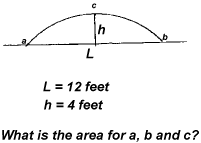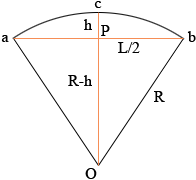 |
 |
|
I assume this is a secondary class problem.
|
|
Hi Larry. We reproduced the diagram you sent
If you draw radii from the center of the circle to the end points of the chord, you will have a circular sector (a pie slice). The lines we've drawn, together with the chord itself, forms an isosceles triangle (since two sides are radii of the circle). So if we can get the area of the circular sector (pie slice) and subtract the area of the isosceles triangle, we'll have the area of the shape you are seeking (it mathematics we call that a circular segment).
Working in radians, the area of a circular sector is 1/2 R s, where s is the arc length. The arc length is of course just the vertex angle of the sector (the angle aOb formed by the two radii), which we'll call theta, times R, making the area of the circular sector 1/2 R2 theta. The area of the isosceles triangle aOb is 1/2 base times height, which is L/2 So if we subtract these, we get A = 1/2 R2 theta - L/2 What remains is to determine R and theta from the information you have, L and h. The triangle bPO is a right triangle so from Pythagoras theorem
Expand and solve for R to get
For your example L = 12 feet and h = 4 feet so
From the diagram sin(bPO) = L/(2R) so
Thus the area you want is
Hope this helps!
|
 |
 |
 |

